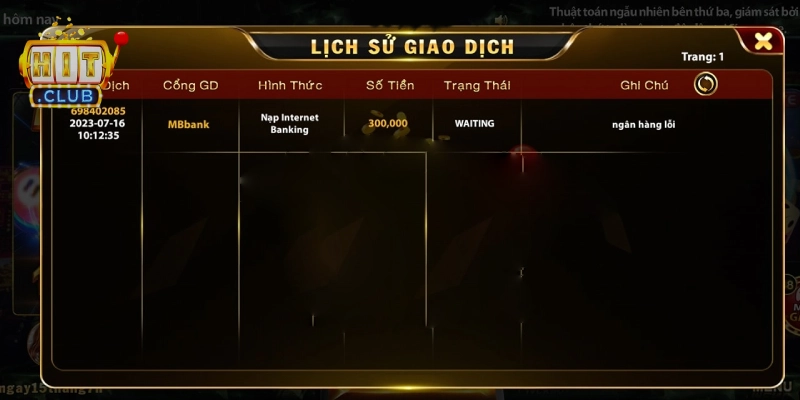Hitclub – Sân Chơi Đẳng Cấp Cho Các Hội Viên Châu Á
Tìm đúng Hit.Club chính gốc để nhận thưởng thật, mọi đường link khác đều là lừa đảo
Hitclub là một trong những thương hiệu giải trí đẳng cấp hàng đầu tại làng giải trí 2025. Cổng game sau nhiều năm hoạt động trong giới đã mang đến các sản phẩm và dịch vụ chất lượng cho người chơi. Hãy cùng tham khảo bài viết của chúng tôi để nắm rõ về cổng game uy tín này nhé.
Những thông tin tổng quan về cổng game uy tín Hitclub
Cổng game được đông đảo hội viên ưa chuộng và giải trí tại làng giải trí trong thời gian trở lại đây. Lần đầu tiên sân chơi được ra đời vào năm 2010 tại Philippines với gần 15 năm hoạt động trong giới.
Đặc biệt, thương hiệu còn được cấp giấy phép bởi tổ chức PAGCOR, chứng minh độ uy tín của mình. Sau một thời gian dài hoạt động, cổng game đã trở thành một trong những điểm đến uy tín được nhiều người ưa chuộng hiện nay.

Bên cạnh đó, cổng game cũng không ngừng đổi mới và phát triển các sản phẩm và dịch vụ hấp dẫn của mình. Số lượng thành viên tại đây ngày càng tăng lên theo cấp số nhân, sở hữu hơn 15 triệu lượt đăng ký.
Một số ưu điểm tuyệt vời khi tham gia sân chơi Hitclub
Cổng game được đông đảo mọi người ưa chuộng và lựa chọn trải nghiệm đông đảo tại làng giải trí châu Á. Hãy cùng tham khảo một số điểm cộng của cổng game để nắm rõ hơn về sân chơi của chúng tôi nhé.
Bảo mật an toàn
Ưu điểm đầu tiên khi tham gia sân chơi Hitclub chính là hệ thống bảo mật an toàn. Cổng game rất chú trọng đến vấn đề an toàn cho các thành viên trong quá trình giải trí với phần mềm mã hóa nhiều lớp.
Với phần mềm SSL 128bit an toàn, mọi người không còn phải lo lắng vấn đề thông tin cá nhân bị tiết lộ ra bên ngoài. Không chỉ vậy, sân chơi cũng có hệ thống phát hiện gian lận để kịp thời phát triển và xử lý kịp thời.
CSKH chuyên nghiệp, tận tình
Nhắc đến thương hiệu giải trí Hitclub, không thể phủ nhận hệ thống chăm sóc khách hàng rất chuyên nghiệp. Hiện tại, người chơi có thể liên hệ với bộ phận tư vấn của chúng tôi thông qua nhiều phương thức như hotline, email, mạng xã hội,…

Bên cạnh đó, các tư vấn viên của chúng tôi cũng có chuyên môn cao và sẵn sàng hỗ trợ khi người chơi cần. Mọi phản hồi của người tham gia đều sẽ được ghi nhận và phản hồi đầy đủ. Dù là trong thời điểm nào, mọi người cũng sẽ được hỗ trợ trong thời gian sớm nhất mà không cần phải chờ đợi lâu.
Giao diện ấn tượng
Cổng game Hitclub còn được đánh giá cao với thiết kế giao diện đầy ấn tượng và sang trọng. Với màu sắc vàng và đen chủ đạo, sân chơi hiện lên trong mắt hội viên với vẻ đẹp đầy ấn tượng. Không chỉ vậy, cổng game còn được thiết kế với đồ họa sang trọng và chân thực giúp nâng cao trải nghiệm cho người tham gia.
Ngoài ra, các tính năng tại đây cũng được thiết kế theo phong cách khoa học và hiện đại. Dù là những người mới bắt đầu vẫn có thể thỏa sức trải nghiệm giải trí tại đây.
Đa dạng trò chơi
Cổng game Hit Club nổi tiếng trong mắt người chơi bởi đa dạng các sản phẩm được hệ thống cung cấp. Sân chơi đã hợp tác với nhiều đơn vị trong giới game để mang đến các sản phẩm chất lượng hấp dẫn.
Với số lượng các trò chơi được cung cấp, hội viên có thể thỏa sức giải trí mà không cần phải mất công tìm kiếm. Không chỉ vậy, các tựa game này còn được đánh giá cao với tỷ lệ trả thưởng hấp dẫn và xanh chín. Người chơi do đó có thể dễ dàng kiếm được những khoản tiền giá trị trong quá trình giải trí.
Nạp rút tiền nhanh chóng
Đến với cổng game Hitclub, hội viên còn được hỗ trợ thủ tục nạp rút diễn ra nhanh chóng và thuận lợi. Hiện tại, sân chơi cung cấp đa dạng hình thức giao dịch khác nhau rất tiện lợi. Trong đó, mọi người có thể lựa chọn những cách như ví điện tử, ngân hàng hay thẻ cào,…

Bên cạnh đó, tốc độ xét duyệt nạp rút tiền tại đây diễn ra nhanh chóng nên không làm mọi người phải chờ đợi quá lâu. Nếu làm theo đúng hướng dẫn, mọi người có thể chuyển tiền thành công chỉ trong 1 đến 3 phút.
Nhiều ưu đãi hấp dẫn
Ưu điểm tiếp theo khi trải nghiệm giải trí tại Hitclub phải kể tới các chương trình khuyến mãi hấp dẫn. Dù là người chơi mới bắt đầu hay đã có nhiều năm hoạt động đều có cơ hội tham gia các ưu đãi. Hệ thống thường xuyên cập nhật khuyến mãi hay các giftcode để tăng thêm cơ hội kiếm tiền thưởng cho người tham gia.
Đặc biệt, các ưu đãi mà cổng game cung cấp đều rất giá trị, giúp mọi người làm giàu nhanh chóng. Từ đó, mọi người có thể tranh thủ cơ hội để kiếm tiền thường giá trị từ sân chơi.
Những sản phẩm hấp dẫn tại cổng game uy tín Hitclub
Đến với cổng game, hội viên sẽ có cơ hội trải nghiệm đa dạng trò chơi hấp dẫn. Hãy cùng tham khảo ngay những siêu phẩm thú vị khiến ai cũng thích thú khi trải nghiệm hiện nay nhé.
Game bài đổi thưởng
Một trong những sản phẩm hấp dẫn được nhiều người trải nghiệm hiện nay chính là game bài đổi thưởng. Cổng game được đánh giá cao với các siêu phẩm đánh bài 3D chân thực và hấp dẫn từ truyền thống đến hiện đại. Các bàn cược đều được thiết kế với giao diện trực quan mang đến cảm hứng cho người tham gia.
Tại cổng game Hitclub, mọi người sẽ được thưởng thức các trò chơi quen thuộc đối với nét văn hóa Việt Nam. Chuyên mục cũng được cập nhật liên tục để mang đến trải nghiệm khó quên cho người tham gia. Tại đây, anh em có thể thưởng thức một số sản phẩm như Sâm lốc, Tiến lên miền Nam, Liêng, Bài cào,…
Slot game online Hitclub
Đến với cổng game, mọi người còn có cơ hội trải nghiệm những ván chơi slot đầy ấn tượng và dễ trúng. Tại sân chơi cung cấp đa dạng sản phẩm thú vị với thiết kế đầy ấn tượng khiến ai cũng thích thú khi trải nghiệm. Bên cạnh đó, các sản phẩm có số lượng lớn nên khiến ai cũng hài lòng khi trải nghiệm.
Đến với chuyên mục nổ hũ, mọi người có thể thưởng thức một số siêu phẩm như Kho báu Aztec, Avengers, Pirate King, Angry Birds… Mỗi trò chơi tại Hitclub đều có đặc điểm riêng giúp tăng thêm tính giải trí trong quá trình trải nghiệm.

Điểm đặc trưng của slot game chính là mang đến các hũ jackpot giá trị lên tới hàng trăm triệu đồng. Từ đó, mọi người hoàn toàn có thể yên tâm trong quá trình giải trí tại cổng game.
Các sản phẩm Live
Casino online cũng là một trong những sản phẩm thú vị đáng trải nghiệm tại cổng game uy tín Hitclub. Người chơi sẽ được thưởng thức các bàn chơi sang trọng không hề thua kém sòng bài casino Las Vegas ngoài đời thực. Hội viên sẽ có cảm giác chân thực khi thưởng thức các ván chơi casino ấn tượng tại đây.
Đặc biệt, mỗi bàn chơi đánh bài tại cổng game đều được hỗ trợ và chăm chút nhiệt tình của Dealer. Hội viên giờ đây có thể thưởng thức một số siêu phẩm casino điển hình như Roulette, Rồng hổ, Baccarat, Xóc đĩa, Sicbo…
Mini game
Với những người mới bắt đầu tham gia tại cổng game, sẽ thật thiếu sót nếu bỏ qua mini game. Các siêu phẩm mini game tại đây đều được thiết kế ấn tượng, thời gian ngắn giúp mọi người làm quen quy luật nhanh chóng. Không chỉ vậy, hội viên cũng có thể dễ dàng kiếm tiền thưởng chỉ trong thời gian ngắn tại sân chơi.

Cổng game Hitclub cũng thường xuyên cập nhật đa dạng các sản phẩm mini game hot như Kim Cương, Mini Poker, Cao Thấp, Mini tài xỉu, Money trees,… Đảm bảo với cốt truyện hấp dẫn cùng tỷ lệ thưởng xanh chín, các siêu phẩm tại đây đều khiến người chơi thích thú khi trải nghiệm.
Các trò chơi khác
Đến với Hitclub, hội viên ngoài thưởng thức những sản phẩm bên trên còn được thưởng thức đa dạng sản phẩm khác. Cổng game cũng thường xuyên cập nhật các trò chơi thú vị để mang đến trải nghiệm thú vị cho người tham gia. Dưới đây là một số sản phẩm điển hình để anh em thỏa sức trải nghiệm tại sân chơi:
- Bắn cá
- Đảo vàng
- Lô đề
- Thể thao
- Number game
- Keno
- …
Hướng dẫn đăng ký tài khoản tại cổng game Hitclub siêu nhanh
Đến với cổng game Hitclub, anh em sẽ có cơ hội trải nghiệm đa dạng trò chơi hấp dẫn cùng tỷ lệ thưởng cao. Hãy cùng tham khảo ngay các bước đăng ký tài khoản đơn giản tại cổng game dưới đây nhé.

- Bước 1: Người chơi trước tiên cần phải truy cập vào đường link chính thức đến cổng game. Tại đây, hãy click vào ô Đăng ký hiển thị trên màn hình để bắt đầu tạo account tại đây.
- Bước 2: Điền đầy đủ các thông tin cá nhân của hội viên theo yêu cầu của sân chơi. Cụ thể, anh em cần phải nhập dữ liệu về tên đăng nhập và mật khẩu tại cổng game Hitclub để bắt đầu. Đừng quên kiểm tra các dữ liệu để đảm bảo tính chính xác khi đăng ký.
- Bước 3: Sau khi điền xong các thông tin, mọi người cần phải xác nhận thủ tục tạo account tại cổng game. Cuối cùng, hãy đăng nhập và thưởng thức các ván chơi hấp dẫn tại đây.
FAQ – Một số câu hỏi thường gặp liên quan đến cổng game Hitclub
Dưới đây là một số câu hỏi thường gặp về sân chơi để có cái nhìn tổng quan về cổng game.
Thủ tục đăng ký tài khoản tại cổng game có mất phí hay không?
Người chơi không cần mất bất cứ khoản phí nào để tạo tài khoản tại cổng game và chơi game.
Nguyên nhân không rút được tiền tại sân chơi Hitclub là gì?
Thủ tục rút tiền khá đơn giản nhưng người chơi đôi
khi không thể thành công. Một số nguyên nhân điển hình như internet không ổn định, hội viên vi phạm điều khoản hay hạn mức vượt quá phạm vi cho phép.
Tin đồn lừa đảo của cổng game Hitclub có thật không?
Đây hoàn toàn là những thông tin sai lệch khi cổng game đã được cấp phép bởi chính phủ Philippines. Bên cạnh đó, các tin đồn cũng đều vô căn cứ nên mọi người cần tỉnh táo khi tiếp cận.
Trên đây là một số thông tin quan trọng về cổng game đổi thưởng uy tín Hitclub. Sân chơi luôn được đánh giá cao với các sản phẩm và dịch vụ ấn tượng khiến ai cũng thích thú. Hãy nhanh tay đăng ký và thưởng thức các ván chơi thú vị tại sân chơi ngay hôm nay nhé.



